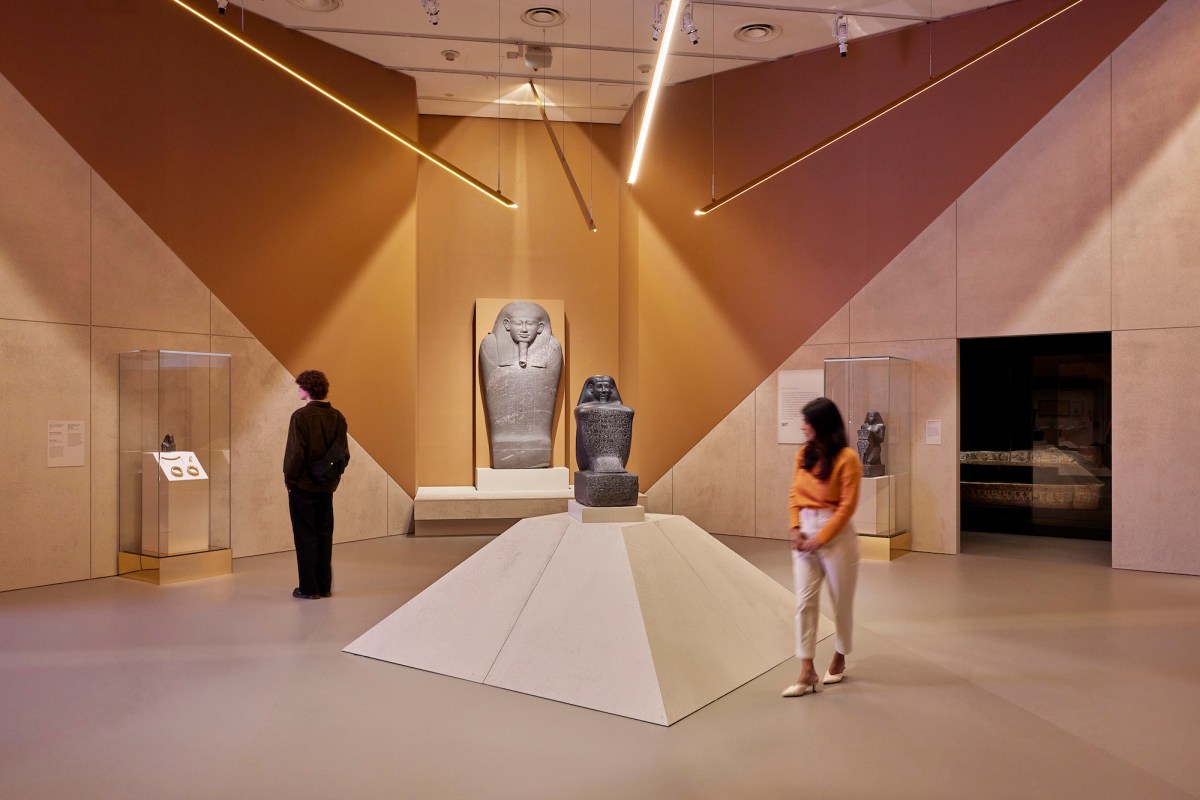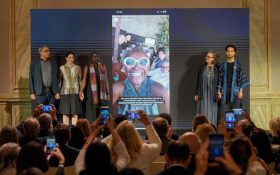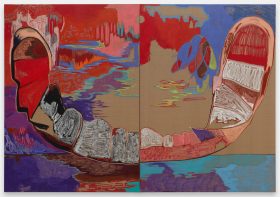Australia has had its share of Egyptian exhibitions – ancient relics of an alluring past usually presented in a heavily didactic, museological vernacular. Viewing these shows almost feels dusty, textbook-like, where little is done to move beyond “show and tell.”
In some ways, it has been lazy exhibition making, too caught up in respecting tradition, rather than shaking it up, respectfully. Pharaoh gets that nuance, and magically balances both.
Walking through this exhibition, one is constantly aware that is it presented in a gallery – rather than a museum – setting. Exhibition design, and the viewer experience, are just as key to this exhibition’s success as the objects themselves. It surprised me that the accompanying publication does not acknowledge this.
Pharaoh has travelled from the British Museum in London – that edifice of history that has recently been more in the news for what it has “stolen” than what it is showing. The exhibition coincides with the airing of Marc Fennell’s television show Stuff the British Stole.
The British Museum is said to have 100,000 artefacts with just 4% on display – so the 500-plus objects destined for Melbourne is a mere toe-dip.
It is the first collaboration between the organisations, and is the largest exhibition ever to be toured by the British Museum in its 270-year history. It is also the largest exhibition of Egyptian art to be presented in the southern hemisphere. So, yes, understandably it is impressive, and well worth its ticketed entry.
The exhibition has been eight years in the making, led by British Museum’s Curator Funerary Culture of the Nile Valley, Marie Vandenbeusch. Exhibition designer Peter King (Studio Peter King, aka the designer behind the success of Melbourne Now, Escher x nendo and Dior), was brought on two years ago to help navigate viewers through the layered narrative.
The exhibition is broken into eight thematic streams, moving beyond mere kings to everyday Egypt and the life of the skilled craftspeople, to diplomacy and political life, to eternal life.
The exhibition has the energy and pace of discovery – one walks down architectural vistas with shafts of light and great height, then pops into tomb-like spaces revealing treasures. And, as one weaves (and delightfully gets lost) through the progression of rooms, the use of light subtly shifts from night to day. It almost has a cinematic quality.
Mirrors and cut-through windows, allow visitors to view the objects from multiple, and surprising angles, always drawing you deeper into the exhibition’s treasures.
A soundscape has also been composed for the exhibition. King tells ArtsHub that in designing the space he was ‘thinking of that idea of viewership. These things are designed to be seen – to impress’.
This exhibition not only delivers, it bewitches, seduces, charms and intrigues. We are transported and transfixed. We are caught between the past and the very palpable experience of these objects in our time.
And the objects themselves?
After an obscured entry (we are made to work to discover) the initial gallery is pretty sparse with a number of heads and small items. The hero image of the exhibition’s marketing is encountered in this first gallery – an elegant grey-green siltstone carving of Head of Thutmose III, one of ancient Egypt’s most successful military pharaohs of the 18th Dynasty who expanded Egypt’s empire to its greatest extent.
Also here you’ll find the smallest object in the exhibition, at just five centimetres – a small ivory sandal label (yes, from a shoe, just like a Croc Jibbitz) depicting King Den of the 1st Dynasty. The scene, however, is far from frivolous – the smiting of an enemy, a theme persistent across the 3000-year history on show.
This push and pull of scale continues right across the exhibition very successfully, as it move across the forecourt of the NGV taking up the entire lower level galleries.
Among the highlights is a room edged in a parade of 10 statues of the Lion Goddess Sekhmet – who was known as “the Powerful One”. She is a surprising addition to the male-dominated narrative of the gods.
Within sight of this parade is an enormous stone fist (the largest fist pump ever?) weighing over 1.5 tonnes. It is from a colossal statue of Ramses II (c.1279-1213 BCE) from the temple of Ptah, at Memphis. Nearby, in a similar red granite, and with a weighty presence, is another highlight – a lion, which is one of a pair made around 1390 to 1352 BCE to guard a temple erected by the Pharaoh Amenhotep III.
What I love about the experience of Pharaoh is that you can get lost in the eddies and narratives of a single room, or object – like this lion, which Amenhotep III’s grandson Tutankhamun ordered to be reinscribed, to add his own name. Then, a thousand years later, it was again reinscribed by Kushite king Amanislo, who moved the lions to the kingdom of Kush in modern day Sudan.
Equally, you can just let these objects in their enormity wash over you in all their splendour. There is no correct way to experience this exhibition, and it easily invites a return visit.
One room you will be sure to revisit, is the presentation of jewels. Painted a soft aqua, the walls seemingly are washed by the lapping waters of the Nile, dramatised by reflective columns. Among the highlights in this room is a statue of Horemheb and his wife (18th Dynasty from the reign of Tutankhamun). The intimacy in the gesture of the couple – in particular the carving of the held hands – is both stunning and emotionally touching.
The sculpture is uninscribed, and for many of the 180 years since it was discovered it was unidentified. Preparing for the exhibition, many of the pieces were conserved, allowing for new information to come to light on the objects.
There are too many objects to speak about. And every visitor to this exhibition will find connection with different pieces on display. I cannot speak highly enough of this exhibition – it is a masterpiece of exhibition design, of institutional collaboration, and for rethinking how we engage with history in our time with its demand for immersive experiences – without selling out to tech or clichés.
Pharaoh
NGV International
2024 Melbourne Winter Masterpieces exhibition
14 June – 6 October 2024; ticketed
Pharaoh also has a free exhibition for children and families in the NGV’s children’s gallery, plus special programming for NGV Friday Nights.
The writer travelled to Melbourne courtesy of the NGV.





